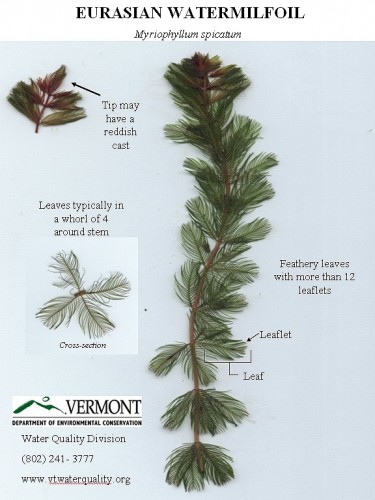The Aquatic Invasive Species Prevention program at Seymour Lake was founded in 1999 when, then president and vice president of the SLA, Joan Witzmann and Beth Torpey, submitted the first grant to the state of Vermont. This was the first year that Vermont Department of Environmental Conservation (DEC) offered grants for aquatic invasive species prevention and selected Seymour Lake as one of the first lakes to monitor incoming watercraft.
The original program involved both “Greeter” and “Patroller” components. The Greeter Program consists of employees “greeting” boaters at the state fishing access and inspecting watercraft for “hitchhikers” from other waterbodies, as well as educating the public about the dangers of aquatic invasive species. The Patroller component entails the examination of the bottom of the lake for aquatic vegetation and identification of potential aquatic invasive species.
Today, in the Greeter Program, up to 10 people per season are employed to work at the fishing access 7 days/week, 12 hours/day (13 on Saturdays) from Memorial Day until the end of fishing season (October 31). A hot water Boat Decontamination Station (BDS) was added to fight animal invasive species. Targeted decontamination is performed on watercraft that may have been exposed to animal invasive species on other lakes.
- Watercraft Decontamination
In partnership with the Town of Morgan and with significant backing of the now deceased Seymour Lake Association board member, Kalman Samuels, the program has been successful for over two decades! Many thanks go to the numerous volunteers over the years, especially to Janet Selby, who managed the program for eight years.
Eurasian Water Milfoil was the original aquatic invasive species of concern but over the years many more aquatic invasive species have migrated in our direction. Most of these organisms come from the Great Lakes, through the Erie Canal, into Lake George and then up to Lake Champlain. From there it’s a short hop over to the Northeast Kingdom! Currently, Lake Champlain is known to have over 50 invasive species while the Great Lakes hosts over 180 species.
An even more immediate threat was identified several years ago with the discovery of zebra mussels in Lake Memphremagog a mere 20 minutes away! The zebra mussel veliger (fertilized, free-swimming larva) is microscopic, making it much more difficult to keep out of our pristine waterbody. A veliger can survive in a drop of standing water for over 30 days, so the practice of “Clean, Drain and Dry” is even more important. It’s recommended that a watercraft that has been in a waterbody with zebra mussels wait for at least 30 days before entering a waterbody without animal invasive species. Waterbodies that are infested with zebra mussels in Vermont include: Lake Memphremagog, Lake Champlain and Lake Bomoseen.

Links to DEC websites and aquatic invasive species of concern:
- Gallery of Invaders:
https://dec.vermont.gov/watershed/lakes-ponds/aquatic-invasives/gallery
- Eurasian Milfoil:
https://nas.er.usgs.gov/queries/FactSheet.aspx?SpeciesID=237
- Zebra Mussels:
https://vtinvasives.org/news-events/news/zebra-mussels-still-a-threat-to-vermont
https://nas.er.usgs.gov/queries/factsheet.aspx?speciesid=5
- Starry Stonewort: https://nas.er.usgs.gov/queries/FactSheet.aspx?SpeciesID=1688
- Spiny Waterflea:
https://nas.er.usgs.gov/queries/factsheet.aspx?SpeciesID=162
- Interactive VT AIS Map
https://dec.vermont.gov/watershed/lakes-ponds/aquatic-invasives/monitoring/vips
- VT Infected Waterbody List:
https://dec.vermont.gov/sites/dec/files/wsm/lakes/AIS/GreeterPage/InfestedWaterBodies2021%20.pdf
- Lake Score Card:
https://dec.vermont.gov/watershed/lakes-ponds/data-maps/scorecard
If your watercraft has been in Lake Memphremagog or Lake Champlain, it’s recommended that you stay out of Seymour for at least 30 days!!!
The Patroller Program has morphed into the Vermont Invasive Patroller (VIP) program and is managed by David Wieselmann. Many of you may have seen David, diligently patrolling the lake in his red and orange kayak. The lake split up into 11 different sections where people have volunteered to patrol. Training is provided and more volunteers are always needed!
Several years ago, David developed the following interactive map of the location, identification and density of native plant species on the lake bottom:
This map is updated on a yearly basis, so we have an idea of what is growing, where and how much.
- Vermont Invasive Patrollers (VIP)
https://dec.vermont.gov/watershed/lakes-ponds/aquatic-invasives/monitoring/vips
Many people don’t know that there are regulations that prohibit the transport of invasive species on a trailer. A person can be fined up to $1,000 for having plant material on their trailer! The plant material doesn’t even need to be invasive.
Laws and Regulations:
https://dec.vermont.gov/watershed/lakes-ponds/aquatic-invasives/laws-and-regs
- Vermont Law Prohibits the transport of any Aquatic Plants and Aquatic Invasive Species
https://dec.vermont.gov/sites/dec/files/wsm/lakes/ans/docs/tranportlawJMupdated.pdf
The Seymour Lake Association has been successfully fighting the introduction of invasive species into our treasured waterbody for over two decades. We need your help to keep our beautiful waterbody free from invaders!
DEC Aquatic Invasive Species Program:
https://dec.vermont.gov/watershed/lakes-ponds/aquatic-invasives
Spread Prevention Maps and Statewide Information:
https://dec.vermont.gov/watershed/lakes-ponds/aquatic-invasives/spread-prevention/statewide-maps
Before moving boats between waterbodies:
- CLEAN off any mud, plants, and animals from boat, trailer, motor and other equipment. Discard removed material in a trash receptacle or on high, dry ground where there is no danger of them washing into any water body.
- DRAIN all water from boat, boat engine, and other equipment away from the water.
- DRY anything that comes into contact with the water. Drying boat, trailer and equipment in the sun for at least five days is recommended if rinsing your boat, trailer parts and other equipment with hot, high pressure water is not an option.
Controlling Invasive Plants
Click here for information on eliminating or controlling invasive species
